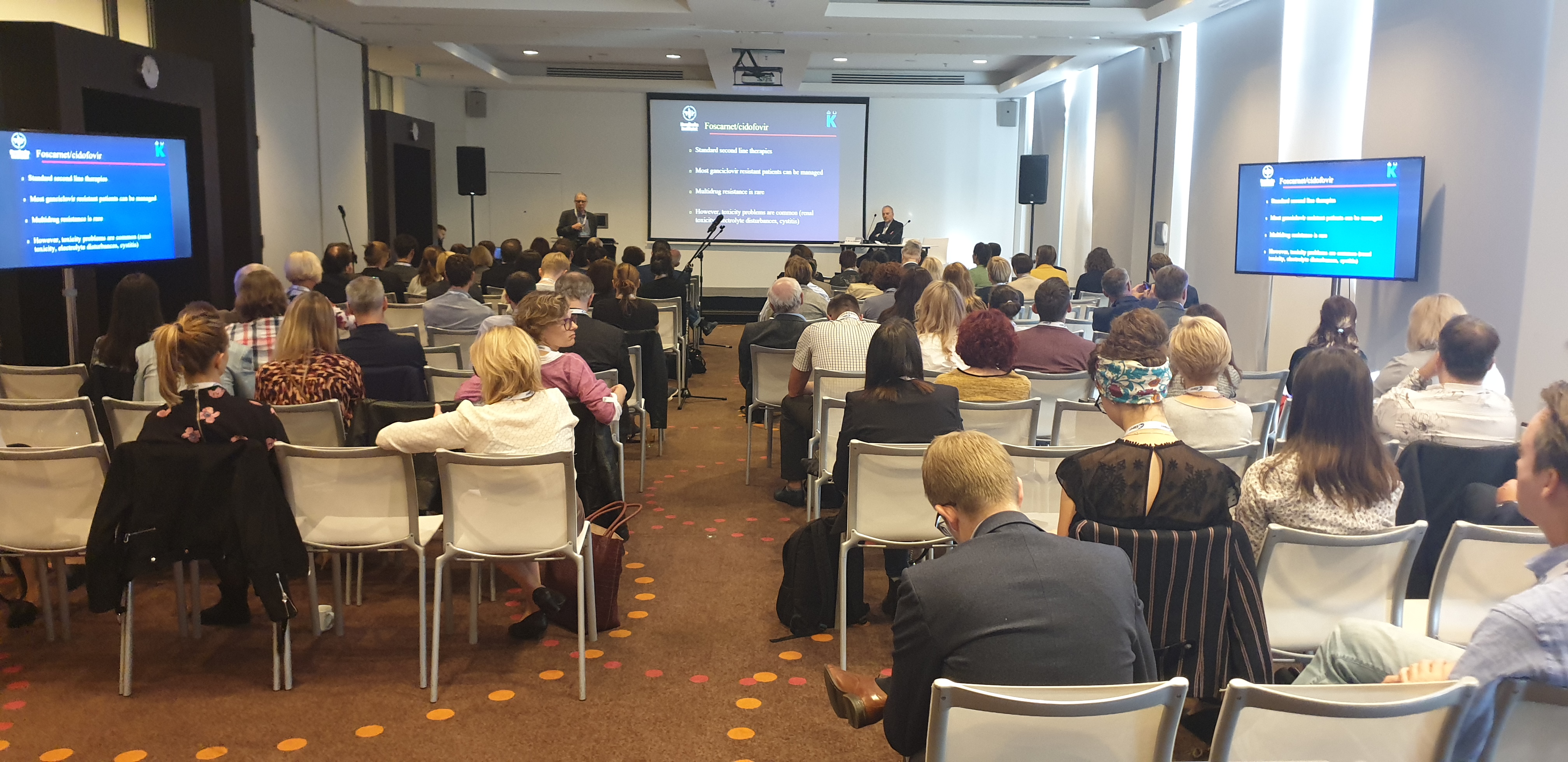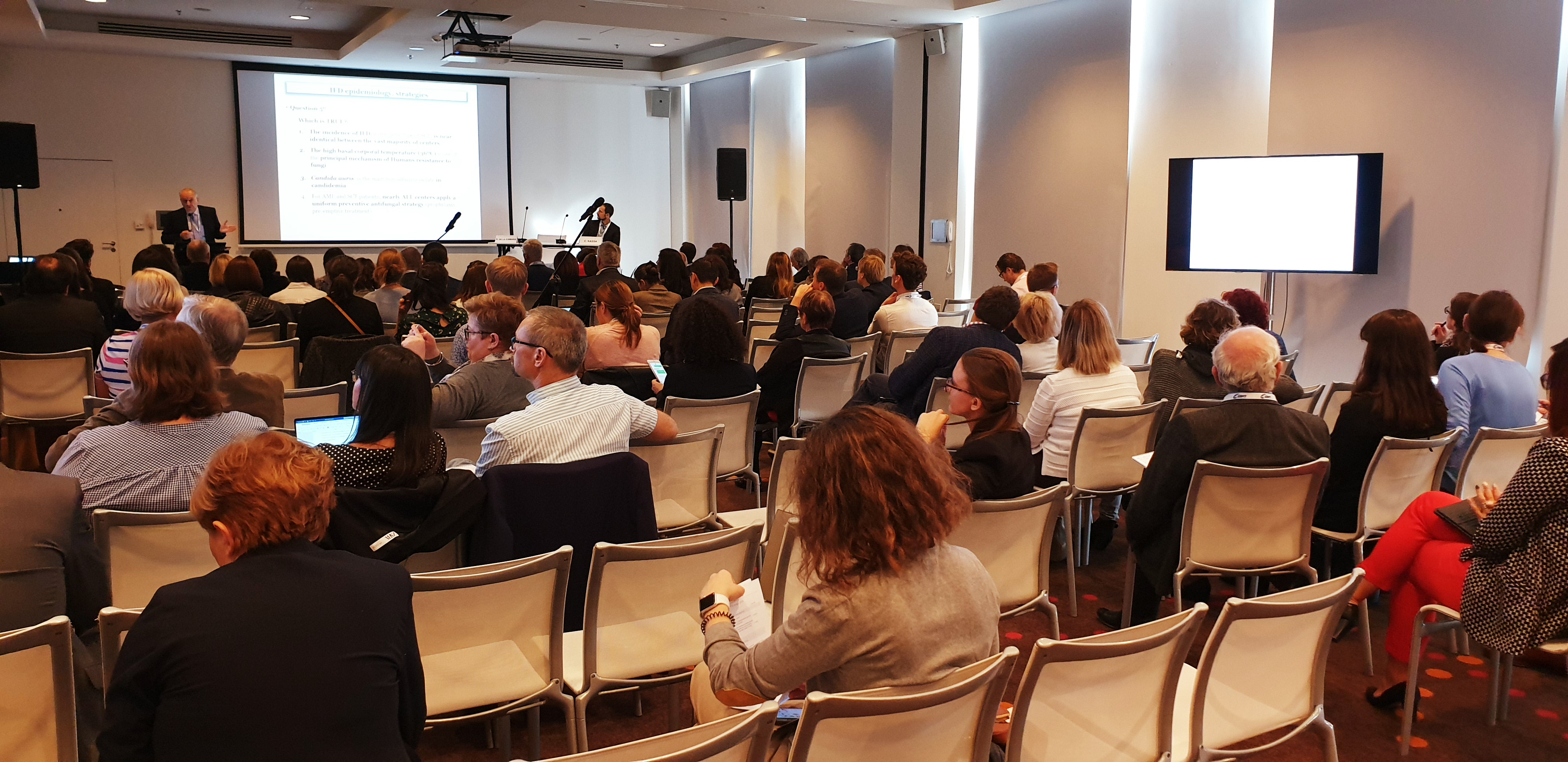
17-19 October 2019 in Krakow, Poland
Session 1: Bacterial infections
Summary by Dina Averbuch, Paediatric Department, Hadassah Hebrew University Medical Center, Jerusalem, Israel
Dina Averbuch talked about bacterial complications following HSCT. Bacterial infections, occurring in up to 30% of patients, contribute to post-transplant mortality. Neutropenia, mucositis, severe GVHD, active malignancy at transplantation, alternative donors and decreased gut bacterial diversity predispose to bacteremia. The worrying epidemiological trends are the increasing proportion of Gram-negative rods (GNR) infections, associated with higher mortality as compared to Gram-positive infections; and also increase in multi-drug resistant (MDR) infections. The multinational EBMT study on GNRs bacteremia demonstrated that half of GNRs are resistant to non-carbapenem beta-lactams, the main empirical treatment option for febrile neutropenia. Nineteen percent of GNRs (mainly Klebsiella pneumoniae, Pseudomonas aeruginosa, and Acinetobacter spp) are carbapenem-resistant; these bacteria are frequently non-susceptible to other treatment options, as fluoroquinolones, aminoglycosides; some are resistant to colistin. Infections caused by resistant GNRs are frequently covered inappropriately by empirical therapy; this being the main explanation for high mortality. On this background, ECIL guidelines recommend for risk-adapted empirical therapy, taking into account patients` risk for resistant infection, clinical presentation, and local epidemiology. Escalation policy using non-carbapenem beta-lactams is appropriate for a stable patient without previous infection or colonization with resistant bacteria in centers with a low rate of resistant infections. Oppositely, de-escalation strategy using carbapenems and appropriate combinations should be used in patients who are unstable, or colonized or previously infected with resistant bacteria or in centers with a high rate of these infections. Later de-escalation based on clinical and microbiological data should be considered. Targeted therapy following bacterial identification should be based on susceptibility data, knowledge on resistance mechanisms, being optimized according to pharmacokinetic/pharmacodynamic principles. Novel beta-lactams, as ceftazidime-avibactam, meropenem-vaborbactam, imipenem-relebactam, and ceftolozane-tazobactam are active against some carbapenem-resistant Gram-negatives. A combination with other active agents should be considered, as resistance is reported and can develop on treatment. Fluoroquinolone prophylaxis may be currently less effective and even contribute to increased risk of multi-drug resistant infections. Antimicrobial stewardship, including antibiotic de-escalation and discontinuation when possible; and infection control are important measures to prevent further spread of resistance.
Finally, successful fecal transplantation in a patient colonized and infected by MDR GNR was presented by Dr. Syuskin.
Session 2: Fungal infections
Summary by Patrycja Mensah-Glanowska, Department of Haematology, Jagiellonian University, Krakow, Poland
Rafael de la Camera opened the session with the Keynote Lecture – a comprehensive review of multiple aspects of invasive fungal infections (IFI). He started with clinical presentation of fungal infections and define levels of diagnosis and analyzed the evolution of IFI in the lungs during treatment, pointing how to interpret imaging and therapy results in neutropenic patients. He addressed the issue of immune reconstitution inflammatory syndrome (IRIS) during fungal infection. Finally, he discussed novel drugs in IFI treatment. To enhance educational mission of meeting, the interactive lecture was followed by case presentations discussing different diagnostic and therapeutic problems in IFI. Varvara Overchina (Sankt Petersburg) described Candida tropicalis infection with unique localization in retroperitoneal space in a child with Hurler syndrome after alloHSCT. Elena Lepik (Sankt Petersburg) presented a case of invasive pulmonary aspergillosis in the patient with angioimmunoblastic T cell lymphoma after haploHSCT and discussed persistence of inflammatory tissue with fungi after voriconazole treatment, despite confirmed sensitivity. Patrycja Mensah-Glanowska (Krakow, Poland) introduced a case of an AML patient after alloHSCT with arterio-venous fistula as a rare complication of surgical IFI removal. She pointed out diagnostic challenges in the patient. Later three presenters focused on mucormycosis. Inna V. Markova (Sankt Petersburg) described a case of pediatric ALL patient with locally advanced mucormycosis and secondary soft palate necrosis. He was treated with both antifungal agents and surgery. Yuliya Rogacheva (Sankt Petersburg) showed a case of Lichteimia corymbifera sinusal infection treated with combination of antifungals – posaconazole and LC-AMB and surgery. She discussed controversies of alloHSCT safety in patients with active pre-existing mucormycosis. Krzysztof Czyzewski (Bydgoszcz, Poland) presented a case of a child with GVHD and long-term immunosuppression, complicated by rhino-orbital infection with multi-pathogenic etiology. Microbiology sinus tissue assessment revealed two molds genus: Aspergillus fumigatus and Lichteimia corymbifera, and bacteria Klebsiella pneumoniae ESBL and Staphylococcus aureus MLSB/MRSA, what allowed the use of targeted therapy. Christoph Buhl (Berlin) showed interesting case of meningoencephalitis with unusual etiology in AML patient after second allogeneic transplant. Pathogen search in this case was especially challenging. Finally, fungus from family Ascomyota Cordicipitaceae was identified, and the patient was successfully treated with combination of voriconazole and L-AMB.
Session 3: Viral infections
Summary by Agnieszka Piekarska, Department of Haematology, Medical University of Gdansk, Poland
Viral infections session was focused on community-acquired respiratory viral (CARV) infections. The Keynote Lecture on CARV infections was delivered by Malgorzata Mikulska (Genova, Italy). She highlighted the current knowledge concerning diagnostic tools, severity criteria, indications for treatment, and therapeutic options for the most common etiological factors. Valentina Porunova from Saint Petersburg State Medical University (Russia), presented a “real-life” case report on influenza A H1N1 in a multiple myeloma patient after high dose chemotherapy and tandem autologous hematopoietic cell transplantation (HCT) with unfavorable outcome despite targeted antiviral treatment. The session was completed with an analysis of four clinical cases focused on different aspects of respiratory viral infections presented by Agnieszka Piekarska from Medical University of Gdansk (Poland). The first topic included an autoimmune inflammatory complication (acute demyelinating encephalomyelitis) of successfully treated influenza A H1N1 in allogeneic HCT recipient. The second one applied to suboptimal response to influenza vaccine and a pulmonary cytomegalovirus reactivation in a patient with chronic graft-versus-host disease. The infectiveness of CARV and a fatal outcome of CARV co-infection in a patient with fungal and bacterial pneumonia were the subsequent raised issues. Presentations were followed by a very vivid discussion on necessity to vaccinate the entire transplant personnel against influenza and different strategies to convince hospital staff to have themselves vaccinated. Common respiratory infections in nurses and physicians being present at their workplace was another unsolved problem due to the shortage of hospital staff. Professor Mikulska highlighted a need to pay particular attention to the type of mask filters used by personnel with respiratory symptoms because those with free airflow make the infectious droplets spread easy. The attendees of a debate concluded that in the case of staff shortage, the only option to decrease the risk of spreading CARV would be to transfer those with symptoms of respiratory infections to the computer work.
Session 5: Infections after CAR-T therapy
Summary by Lidia Gil, Physician, Department of Hematology, Poznan University of Medical Sciences, Poznan, Poland
Infections after CAR T cell therapy was one of the most interesting session. It included Keynote lecture delivered by Lidia Gil about infectious complications after CAR T cell therapy and case reports concerning this issue, presented by Luisa Sisinni (Madrid, Spain) and Gida Del Baldo (Rome, Italy). CAR T cell therapy, the most innovative cellular immunotherapy in the treatment of lymphoma, requires specialistic management. As the number of certified centers and completed procedures is still low, each clinical problem is discussed with details. Regarding infectious complications after CAR T cell therapy their characteristic, incidence and risk factors were presented. During discussion proposal for prophylaxis was suggested, as well as prospective study in the field.


